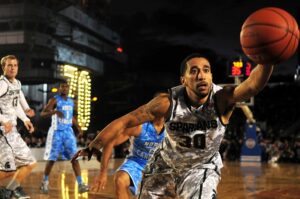
When you’re not at work, you’re at your computer trying to figure out the next step in your career. You’ve been working in sales for six years now, and you’ve reached a point where the days run together, you don’t feel recognized, and you have the desire to pursue sports jobs.
After a lot of research and self-reflection, you decide you want to work in sports PR. The transition may be difficult, but you’re willing to put in the time.
That’s a major issue many job seekers like you face — time management. If you’re looking to make a career change or preparing to enter the workforce for the first time, you need to know how to strategize and manage your time.
Let’s take a look at our job seeker’s March Madness bracket, so you know how to best spend your time:
Online Job Posting vs. Employee Referral
You have a lot of opportunities to find sports jobs. Job boards are a great place to start. However, this isn’t the only way to find your next opportunity.
iCIMS’s 2015 report found that most employers hire nearly 40 percent of their staff from employee referrals. When someone else speaks highly of you and recommends you for an open role with their employer, you are much more likely to be seen and considered.
Referrals are so valuable because hiring managers have more than just your online application to determine your value. This is why you need to invest time into networking.
Here are some quick tips for networking:
- Pay attention to your body language
- Strengthen your communication skills
- Prepare an elevator speech
- Schedule follow-ups
- Set goals for each event you attend
- Focus on being authentic
- Share your passion
What wins: Referrals are often faster to hire and result in a better candidate and employee experience. The 2015 ICIMS study also found that more than half of the 107 HR professionals surveyed agree that referred employees stay longer, feel more satisfied, and are better cultural fits.
However, a well-balanced strategy for finding sports jobs requires both online job board searching and professional networking. Make sure you focus time on both aspects.
Resume vs. Cover Letter
This question always arises — are cover letters worth your time?
First, let’s look at the hiring manager’s process. They will filter out unqualified applicants using their applicant tracking system, then start to look at each candidate. Ensure you don’t slip through the cracks by matching keywords with their posting.
For example, if a sports job posting uses terms like “coordinate customer engagements” and “organizational skills,” make sure you add those keywords to your resume. When you know how to tailor your resume, you increase your chances of being seen by a hiring manager.
As CareerArc’s State of the Candidate Experience study found, 72 percent of employers spend less than 15 mins reviewing an application. That means you need to share your value quickly and in a memorable way.
A cover letter is a great tool for you to share who you are and what makes you unique. Contrary to most people’s understanding, cover letters are more than just an extension of your resume.
The purpose is simple — tell your story. Throw out your templates. If a hiring manager reviews six applications in an hour, your template will blend into everyone else’s.
You need a story that’s memorable, personal, and to the point. Be true to yourself and your writing voice, then deliver a story of how you overcame an obstacle or how you developed strong communication skills in sales and want to apply your value to a marketing and public relations role.
What wins: In terms of making yourself memorable, cover letters win big. But in order to be seen, you need a resume that is optimized for the ATS. Tailor your resume to the position, then tell your unique story so you stand out amongst the competition.
LinkedIn Profile vs. Facebook Profile
Your social media presence can make or break your chances of landing a sports job. Employers continue to use social recruiting because they find some of their top performers through it.
LinkedIn’s 2016 trends report found that 43 percent of employers say their top source of quality hires is professional social networks, which is why your professional value needs to be apparent through your online presence.
Keep Facebook professional and appropriate but make your LinkedIn profile a top priority. A strong LinkedIn profile consists of the following:
- A professional photo that accurately captures the tone and image you want to convey
- Short, bulleted points in your summary centered on your skills and achievements
- A clear headline that promotes your personal brand
- A customized public profile URL
- Public endorsements for your skills, as well as personal recommendations
You also want to be active within the LinkedIn community. Join sports industry groups and engage in conversations. Learn more about PR and industry news and trends.
What wins: LinkedIn profiles are crucial to your social media presence as a job seeker. Use it as an opportunity to promote your value to potential employers.
How are you managing your time to find sports jobs?





